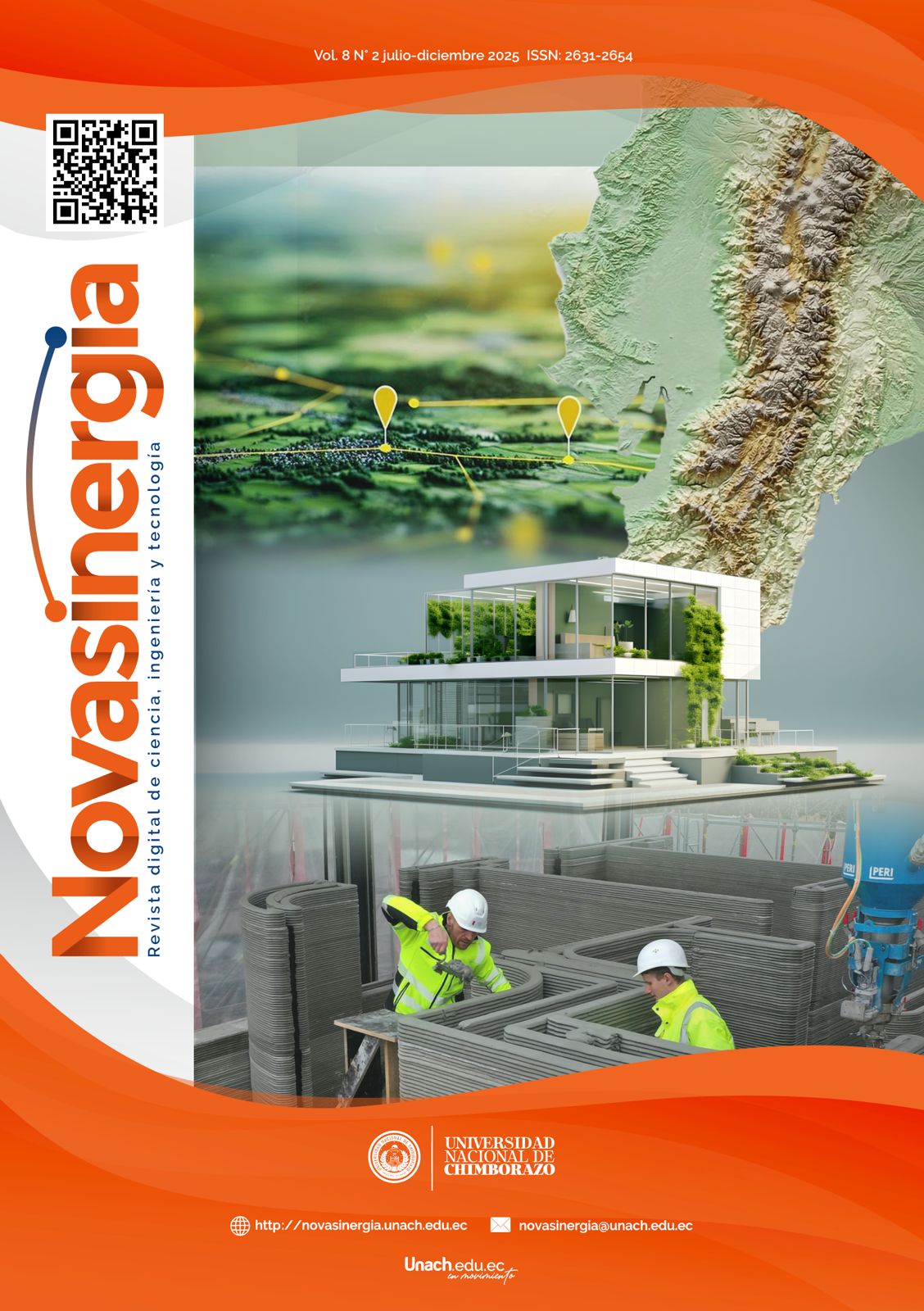Assessment water quality in High Andean ecosystems: a comparative analysis of macroinvertebrate-based indices
DOI:
https://doi.org/10.37135/ns.01.16.03Keywords:
high andean ecosystem, ABI index, BMWP/Col index, EPT index, macroivertebratesAbstract
The study was conducted in the Quinllunga Water Protection Area in Bolívar Province, in the Ecuadorian Andes, with the objective of assessing the water quality of the Diablo Sacha River. Ten monitoring stations were established along the river's course. Three sampling campaigns were carried out, during which macroinvertebrates were collected, and key physicochemical parameters were recorded. To evaluate water quality, the Biological Monitoring Working Party index adapted to Colombia (BMWP/Col), Andean Biotic Index (ABI), and the Ephemeroptera, Plecoptera, and Trichoptera (EPT) index were applied. Additionally, the Simpson Index (D) and the Shannon Index (H') were calculated to assess macroinvertebrate abundance and diversity. A Spearman correlation was performed between D and H' and the physicochemical parameters to determine how environmental quality affects biodiversity. Finally, a principal component analysis (PCA) was conducted to identify how environmental factors at each station influence the composition and distribution of biological communities. Overall, water quality across the 10 sampling points ranged from good to acceptable according to the BMWP and ABI indices, which showed consistent results. However, the EPT index, however, presented discrepancies, classifying the water quality as poor to moderate. The Spearman correlation and PCA further highlighted differences in macroinvertebrate sensitivity depending on habitat conditions.
Downloads
References
.[1] M. Mosquera et al., "Progress in understanding the hydrology of high-elevation Andean grasslands under changing land use," Sci. Total Environ., vol. 804, 2022, doi: https://doi.org/10.1016/j.scitotenv.2021.150112.
.[2] D. Rey, I. Domínguez, y E. Oviedo, “Effect of agricultural activities on surface water quality from páramo ecosystems,” Environ. Sci. Pollut. Res., vol. 29, no. 55, pp. 83169–83190, 2022, doi: https://doi.org/10.1007/s11356-022-21709-6.
.[3] G. Mosquera et al., "Frontiers in páramo water resources research: A multidisciplinary assessment," Sci. Total Environ., vol. 892, p. 164373, 2023, doi: https://doi.org/10.1016/j.scitotenv.2023.164373.
.[4] G. Sotomayor, H. Hampel, R. F. Vázquez, M. A. E. Forio, y P. L. M. Goethals, "Implications of macroinvertebrate taxonomic resolution for freshwater assessments using functional traits: The Paute River Basin (Ecuador) case," Divers. Distrib., vol. 28, no. 8, pp. 1735–1747, 2021, doi: https://doi.org/10.1111/ddi.13418.
.[5] F. Quesada, G. Umaña, M. Springer, y J. Picado, “Variación estacional y características fisicoquímicas e hidrológicas que influyen en los macroinvertebrados acuáticos, en un río tropical”. Revista de Biología Tropical, 68(S2), pp. 54–67, 2020, https://doi.org/10.15517/rbt.v68is2.44332
.[6] F. Correa et al., “Comparison of sampling methods for benthic macroinvertebrates in forested wetlands,” Ecol. Indic., vol. 125, p. 107551, 2021, doi: https://doi.org/10.1016/j.ecolind.2021.107551.
.[7] R. Acosta, H. Hampel, H. González, P. Mosquera, G. Sotomayor y X. Galarza, “Protocolo de evaluación de la calidad biológica de los ríos de la región austral del Ecuador,” ETAPA EP, SENAGUA - DHS, Univ. de Cuenca, Programa PROMETEO SENESCYT, 2014. [En línea]. Disponible en: https://www.researchgate.net/publication/321181495_Protocolo_de_Evaluacion_de_la_Integridad_Ecologica_de_los_Rios_de_la_Region_Austral_del_Ecuador
.[8] P. Coayla, A. Chenaux, C. Moreno, C. Cruz, E. Colque y C. Damboreana, “Benthic macroinvertebrate communities and water quality assessment in high Andean wetlands Callali-Oscollo, Arequipa-Cusco, Peru,” Rev. Mex. Biodivers., vol. 94, 2023, doi: https://doi.org/10.22201/ib.20078706e.2023.94.4206.
.[9] Asamblea Nacional Constituyente de Ecuador, “Constitución de la República del Ecuador,” Registro Oficial No. 449, 20 de octubre de 2008, reformada el 30 de mayo de 2024.
.[10] MAATE, Plan de acción nacional para la conservación, restauración y uso sostenible de páramos, 2023. [En línea]. Disponible en: https://www.ambiente.gob.ec/
.[11] MAATE, Resolución MAATE-DZ5-DAPH-QSSG-2021-001-R: Declaratoria del Área de Protección Hídrica Quinllunga, San Simón, 2021. Disponible en: https://www.ambiente.gob.ec/
.[12] GADIAPSS, Plan de desarrollo y ordenamiento territorial 2021-2023," Gobierno Autónomo Descentralizado de la Parroquia San Simón, 2021. [En línea]. Disponible en: https://www.sansimon.gob.ec/wp-content/uploads/2023/03/PDOT-2021-2023.pdf
.[13] K. Banda, V. Ngwenya, M. Mulema, I. Chomba, M. Chomba y I. Nyambe, “Influence of water quality on benthic macroinvertebrates in a groundwater-dependent wetland,” Front. Water, vol. 5, p. 1177724, 2023, doi: https://doi.org/10.3389/frwa.2023.1177724.
.[14] H. González, E. Crespo, R. Acosta, y H. Hampel, Guía rápida para la identificación de macroinvertebrados de los ríos altoandinos del cantón Cuenca, 2019.
.[15] G. Roldán, “Guía para el estudio de los macroinvertebrados acuáticos del Departamento de Antioquía,” COLCIENCIAS, 1996. [En línea]. Disponible en: https://www.cervantesvirtual.com/obras/materia/roldan-perez-gabriel-guia-para-el-estudio-de-los-macroinvertebrados-acuaticos-del-departamento-de-antioquia-critica-e-interpretacion-resenas-resenas-de-libros-43766
.[16] J. M. Walteros-Rodríguez, Fichas rápidas para la identificación de macroinvertebrados acuáticos, 2018. [En línea]. Disponible en: https://www.researchgate.net/publication/326188106_Fichas_rapidas_para_la_identificacion_de_macroinvertebrados_acuaticos
.[17] C. J. Keylock, "Simpson diversity and the Shannon–Wiener index as special cases of a generalized entropy," Oikos, vol. 109, no. 1, pp. 203–207, 2005, doi: https://doi.org/10.1111/j.0030-1299.2005.13735.x.
.[18] A. Forero, G. Reinoso, y C. Gutiérrez, “Evaluación de la calidad del agua del río Opia (Tolima-Colombia) mediante macroinvertebrados acuáticos y parámetros fisicoquímicos,” Caldasia, vol. 35, no. 2, pp. 371–387, 2013. [En línea]. Disponible en: https://revistas.unal.edu.co/index.php/cal/article/view/41208
.[19] T. Vargas et al., “Ecological river water quality based on macroinvertebrates present in the Ecuadorian Amazon,” Sustainability, vol. 15, no. 7, p. 5790, 2023, doi: https://doi.org/10.3390/su15075790/s1.
.[20] B. Ríos, R. Acosta, y N. Prat, “The Andean Biotic Index (ABI): Revised tolerance to pollution values for macroinvertebrate families and index performance evaluation,” Rev. Biol. Trop., vol. 62, pp. 249–273, 2014. [En línea]. Disponible en: http://www.scielo.sa.cr/scielo.php?script=sci_arttext&pid=S0034-77442014000600017
.[21] I. C. P. Andrade, T. K. Krolow, R. Boldrini, y F. M. Pelicice, “Diversity of EPT (Ephemeroptera, Plecoptera, Trichoptera) along streams fragmented by waterfalls in the Brazilian savanna,” Neotrop. Entomol., vol. 49, no. 2, pp. 203–212, 2020, doi: https://doi.org/10.1007/s13744-019-00751-z.
.[22] G. Roldán, “Los macroinvertebrados como bioindicadores de la calidad del agua: cuatro décadas de desarrollo en Colombia y Latinoamérica,” Rev. Acad. Colomb. Cienc. Exactas Fís. Nat., vol. 40, no. 155, pp. 254–274, 2016, doi: https://doi.org/10.18257/raccefyn.335.
.[23] C. Nieto, D. A. Dos Santos, A. E. Izquierdo, J. S. Rodríguez, y H. R. Grau, “Modelling beta diversity of aquatic macroinvertebrates in High Andean wetlands,” J. Limnol., vol. 76, no. 3, pp. 555–570, 2017, doi: https://doi.org/10.4081/jlimnol.2017.1600.
.[24] A. M. Studholme, L. F. Hipo León, A. C. Ríos Rivera, y C. Recalde, "Altitudinal and temporal variability of four macroinvertebrate communities in Andean streams, Sangay National Park, Ecuador," Entomotrópica, vol. 29, no. 3, pp. 149–158, 2014. [En línea]. Disponible en: https://dialnet.unirioja.es/servlet/articulo?codigo=5034612
.[25] S. Sundaray, "An experimental study on impacts of temperature and salinity on dissolved oxygen in water: Correlation and regression technique," Environ. Sci. Indian J., vol. 7, no. 3, 2012. [En línea]. Disponible en: https://www.tsijournals.com/abstract/an-experimental-study-on-impacts-of-temperature-and-salinity-on-dissolved-oxygen-in-water-correlation-and-regression-tec-2423.html
.[26] S. Magnussen y T. J. B. Boyle, "Estimating sample size for inference about the Shannon-Weaver and the Simpson indices of species diversity," For. Ecol. Manag., vol. 78, no. 1–3, pp. 71–84, 1995, doi: https://doi.org/10.1016/0378-1127(95)03596-1.
.[27] M. Buenaño, C. Vásquez, H. Zurita-Vásquez, G. Parra, y R. Pérez, “Macroinvertebrados bentónicos como indicadores de calidad de agua en la cuenca del Pachanlica, provincia de Tungurahua, Ecuador,” Intropica, vol. 13, no. 1, pp. 41–49, 2018, doi: https://doi.org/10.21676/23897864.2405.
.[28] J. Giacometti y F. Bersosa, “Macroinvertebrados acuáticos y su importancia como bioindicadores de calidad del agua en el río Alambi,” Boletín Técnico, Serie Zoológica, vol. 6, no. 2, pp. 17-32, 2006. [En línea]. Disponible en: https://journal.espe.edu.ec/ojs/index.php/revista-serie-zoologica/article/view/1394
.[29] P. Mena et al., Los páramos del Ecuador: Pasado, presente y futuro, USFQ PRESS, 2023, doi: https://doi.org/10.18272/usfqpress.71.
.[30] D. Vimos-Lojano, H. Hampel, R. F. Vázquez, y F. Martínez-Capel, “Community structure and functional feeding groups of macroinvertebrates in pristine Andean streams under different vegetation cover,” Ecohydrol. Hydrobiol., vol. 20, no. 3, pp. 357–368, 2020, doi: https://doi.org/10.1016/j.ecohyd.2020.04.004.







